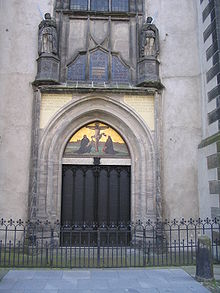All Saints' Church, Wittenberg
| Schlosskirche | |
|---|---|
| All Saints' Church | |
 Apse and belfry of the Schlosskirche | |
 | |
| Location | Wittenberg, Germany |
| Address | Schlossplatz 06886 Wittenberg |
| Country | Germany |
| Denomination | Lutheran |
| Previous denomination | Catholic |
| Website | http://www.schlosskirche-wittenberg.de/ |
| History | |
| Founder(s) | Frederick III, Elector of Saxony |
| Architecture | |
| Architect(s) | Conrad Pflüger |
| Style | Late Gothic |
All Saints' Church, commonly referred to as Schlosskirche (Castle Church) to distinguish it from the Stadtkirche (Town Church) of St. Mary – and sometimes known as the Reformation Memorial Church – is a Lutheran church in Wittenberg, Germany. It is the site where the Ninety-five Theses were likely posted by Martin Luther in 1517,[1] the act that has been called the start of the Protestant Reformation.[2][3]
History
All Saints' Church was designed by Conrad Pflüger[4] and built between 1490 and 1511 at the order of Frederick III, Elector of Saxony[5] in the Late Gothic style.[2][6] It is a part of the Electoral Castle or Residenzschloss, also called Schloss Wittenberg.[5] [6]
After the foundation of the University of Wittenberg in 1502, the All Saints' was annexed to serve as a chapel to the University, and it quickly evolved into an important academic and worship center. Students were awarded their doctorates there, and Philipp Melanchthon made his famous inaugural speech at the church. A tradition of burying academic dignitaries of the university at the church developed.
Tilman Riemenschneider, Jacopo de' Barbari and Albrecht Dürer contributed to the construction of the Schloss and then the church.

95 Theses
It is generally believed that on October 31, 1517, Martin Luther posted his 95 theses on the doors of All Saints' Church. This theses is commonly viewed to be a catalyst for the Protestant Reformation.
Seven Years' War
In 1760, during the Seven Years' War (more specifically the Pomeranian War), the church was destroyed by a fire resulting from bombardment. The blaze left only half of the foundation standing,[7] and none of the wooden doors on which Martin Luther had posted the Theses.[4] All Saints' was soon rebuilt, albeit[6] without many priceless works of art that were lost forever.
Commemorative doors
In 1858, at the order of Frederick William IV of Prussia, commemorative bronze doors were mounted where the original wooden ones had been located.[8] On the doors the 95 Theses are inscribed in their original Latin form.[6] The doors themselves weigh 2,200 pounds (1,000 kg).[7]
On 10 November 1858, 375 years after Martin Luther's birth, the new doors were commemorated at a formal ceremony.
Above the doors is a painting that portrays Luther on the left with a German Bible, and Philipp Melanchthon on the right, with the Augsburg Confession, the main confession of faith in the Lutheran Church which was formed by Luther and Melanchthon.[7] These doors are among the most photographed in Europe.[7]
Renovation
Between 1883 and 1892, All Saints' was renovated and restored under the supervision of J. H. F. Adler by his disciple Paul Ferdinand Groth (1859-1955).[4][6][9]
On 31 October 1892, 375 years after Luther posted his 95 Theses on the doors of the church, All Saints' was re-inaugurated.
New windows
In 1983, 500 years after the birth of Luther, 12 new windows were installed in All Saints'. These honored the most important Reformation students of Luther, and were created by Renate Brömme in a "timeless" style at the order of the Lutheran World Federation.
All Saints' today
Today, All Saints' Church serves not only as a place of worship, but it also houses the town's historical archives, is home to the Riemer-Museum, and a youth hostel.[6][8]
Tower
All Saints' is also known for its 88-metre (289 ft)-tall steeple, from which one can obtain a good view of the city of Wittenberg and the surrounding countryside. A quote, "Ein' feste Burg ist unser Gott" ("A mighty fortress is our God"), from one of Luther's hymns, encircles the tower.[6][7][10][11]
Tombs and artwork
The tombs of Martin Luther and Philipp Melanchthon are located in All Saints' Church.[12][13][14][15] [16] On Luther's tomb, located beneath the pulpit, is enscribed "Here is buried the body of the Doctor of Sacred Theology, Martin Luther, who died in the year of Christ 1546, on February 18th, in his hometown Eisleben, after having lived for 63 years, 2 months, and 10 days." [17] Melanchthon preached at Luther's burial.[18] Luther's casket is buried near the pulpit, some 2.4 metres below the floor of the nave.[19]
Also, there are life-sized statues made from alabaster of Frederick III and his brother John, Elector of Saxony. There are also several bronze sculptures, also of Frederick III and of John which are done by Peter Vischer the Younger and Hans Vischer. In addition, the church has many paintings done by both Lucas Cranach the Younger and Lucas Cranach the Elder.[4][6]
Gallery
-
Interior: view down the nave towards the altar
-
The steeple of All Saints' Church. The inscription "Ein' feste Burg ist unser Gott" runs just below its base.
-
Statue of Saxonian prince-elector Frederick III, "the Wise".
-
Organ
-
Tomb of Prussian Queen
-
Chandelier
References
- ^ "Martin Luther History".
- ^ a b ReformationTours.com
- ^ "Willkommen an der Universität Duisburg-Essen".
- ^ a b c d "8 Top-Rated Tourist Attractions in Lutherstadt Wittenberg".
- ^ a b LutheranWomanToday.org
- ^ a b c d e f g h Sacred-Destinations.com
- ^ a b c d e Unterkunft.Wittenberg.de
- ^ a b "Anhalt-Wittenberg.de".
- ^ "CATHOLIC ENCYCLOPEDIA: Wittenberg (City and University)".
- ^ Chapel.Duke.edu
- ^ TAC-BSA.org
- ^ "Slide Collection".
- ^ Mary Fairchild. "Martin Luther's Great Accomplishments". About.com Religion & Spirituality.
- ^ OurRedeermLCMS.org Archived November 22, 2003, at the Wayback Machine
- ^ "The Cambridge Companion to Martin Luther".
- ^ SignatureToursInternational.com
- ^ "Sacred Places Europe".
- ^ "Martin Luther".
- ^ "Starter".






